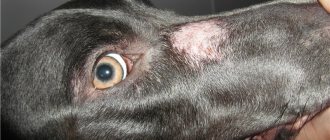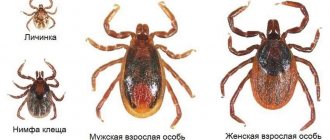Rabies in dogs is a type of disease that every pet owner should know absolutely everything about. The arrival of a puppy in the home undoubtedly brings great joy and happiness. But along with this comes a lot of new troubles and difficulties. And when a pet starts to get sick, many owners panic: how to help their beloved creature, how to alleviate its suffering?
There are many different ailments that dogs are susceptible to. Some arise due to improper care, others due to an inappropriate type of nutrition. And there are diseases that occur due to unforeseen situations. And for some of them, no treatment has been found to date. In case of infection with such a disease, the pet is simply euthanized. Rabies is precisely this type of disease.
To prevent this problem from affecting your four-legged pet, you need to know how to protect yourself and your tailed friend and what to do if infection has already occurred.
What is rabies
Rabies is a fatal viral disease. The virus is a neutropic pathogen, that is, it multiplies and affects the central nervous system and brain. This is what explains the main clinical signs of the disease: aggression, convulsions, reflex excitability, paralysis of the limbs, increased salivation, and so on.
This dangerous disease affects both all warm-blooded animals and humans. The virus is insidious in that an infected pet becomes dangerous from the very moment of the bite until obvious signs of the disease begin to appear. Since treatments for this disease have not yet been developed, there is no hope for recovery. If the animal is not vaccinated, the disease always ends in death.
The outcome is always the same - paralysis and respiratory arrest.
Without a rabies vaccination, an animal is prohibited from participating in breeding, attending exhibitions, or performing service. It is without this vaccination that the animal will not be allowed to travel to other countries and will not be allowed to be transported by rail or air transport.
How can you detect rabies in an animal?
Rabies can only be 100% recognized by blood tests. This is the procedure that must be carried out in a veterinary clinic for any of the above symptoms. Here, responsibility for the health and life of the animal lies entirely with the owner. Inattention and irresponsibility are unacceptable. For the period of time while a clinical study of data and blood processing is being carried out, the animal must be placed in an isolated enclosure, where there is no contact with people or other animals.
In the same way, you can check whether your dog is infected without doing a blood test. To do this, the animal is kept in an enclosure for about 2 weeks and its condition is constantly assessed for compliance with or manifestation of any symptoms from those listed earlier. Of course, the second method will not save the pet’s life, but will only protect other animals and people from becoming infected with the most dangerous viral disease.
Routes of infection
At risk are pets living near steppes, forests and exposed to contact with wild warm-blooded animals (raccoons, foxes, wolves, etc.). In the city, the source of the spread of infection, as a rule, is stray dogs.
In most cases, infection with the rabies virus occurs after a healthy animal is bitten by a sick individual. But you can also become infected through saliva, blood and other fluids of an infected animal. Very often, when playing, dogs lightly bite each other’s nose, lips, and ears. And if the saliva of a sick dog gets through the smallest crack or wound (and there are any number of such on an animal’s body) into the body of a healthy animal, then consider that that’s it, the pet is 100% infected.
Even if a new acquaintance has no visible signs of illness, but it is at this moment that the rabies virus goes through the incubation period, then the dog is considered already sick. Be that as it may, it is unfortunate, but in the early stages it is sometimes very difficult to identify a sick animal. Therefore, try to protect your pet from contact with dogs that you do not know or whose health you are not sure about.
Despite the fact that rabies in dogs is spread in several ways, a bite is considered the only proven way of contracting the virus.
Content
1. Rabies - definition 2. Possible routes of infection 3. Features of the incubation period 4. Symptoms and signs indicating that a dog is infected with rabies 5. How can rabies be detected in an animal 6. Is it possible to cure rabies 7. Basic preventive measures, organization of treatment 8. Correct solution 9. Video
Rabies in dogs is a dangerous viral disease that is practically untreatable and, after the appearance of characteristic symptoms, almost always ends in death. The deadly virus is transmitted through a bite or close contact between animals, and people are also at risk.
The dog owner should know all the main symptoms of rabies in the dog, as well as the procedure to follow if any suspicion arises. Delay in this case is unacceptable, since not just the health of the animal is at stake, but also its very life. In addition, any dog owner should be able to take first aid measures for people bitten by an infected dog. Whether a person gets sick directly depends on correct and timely exposure!
Stages of the disease
The mechanism of the onset and development of the disease can be divided into the following phases:
- Phase I – extraneural. It proceeds without visible signs.
- Phase II – intraneural. At this stage, the virus is already beginning to penetrate the nervous system, the brain and spinal cord. At this stage, the first clinical signs of rabies in dogs begin to appear.
- Phase III – dissemination. This is the phase of spread of the virus from the primary focus to all internal organs and blood. Accompanied by obvious symptoms of disease and death of the animal.
Diagnostics
As already mentioned, rabies may not appear for a long time. Also, the symptoms are very similar to those of other serious diseases, such as:
- Nervous plague
- Meningitis
- Encephalomyelitis
- Aujeszky's disease (Pseudorabies)
A preliminary diagnosis is made on the basis of clinical symptoms, anamnesis (questioning of the owner) and data on the rabies situation in the area where the dog was allegedly infected. Epizootic situation data is a complete collection of information on rabies infection: whether similar cases have been registered and how many, whether rabies has been recorded here at all, how long ago and whether it exists now.
The diagnosis must be confirmed by laboratory tests. One of the fastest and most reliable methods for laboratory diagnosis of rabies is the immunofluorescent method.
Length of incubation period
The incubation period of the disease can last from several days to several months. In most reported cases, it takes 2-2.5 weeks.
Hence the 14-day quarantine established in case of a bite. During quarantine, the dog is placed in a separate room, monitored and tested. In an apparently healthy dog, but already infected with rabies, the virus is already detected in the saliva on days 5-10, before the first clinical signs appear.
If a dog receives an annual rabies vaccination, then in most cases the disease does not occur and the dog is allowed to go home. If during this period of time the animal begins to show signs of illness, it is immediately euthanized.
The length of the incubation period may also depend on the following factors:
- The amount of virus that has entered the animal's body.
- Depth of the wound. The virus targets the central nervous system and the spinal cord or brain. The closer the bite site is to them, the faster the virus will reach its target.
- Resistance (resistance and resistance of the body to external factors).
- Age. Young dogs are much more prone to the disease than older dogs. As a rule, with annual rabies vaccination, stable immunity is developed by the 3rd year of a pet’s life. Until this time, the likelihood of developing the disease, even in a vaccinated young animal, is very high.
That is why young animals must be protected from contact with unfamiliar and stray dogs. How long a dog infected with rabies will live depends on how quickly the symptoms develop. The torment rarely lasts for 2 weeks. As a rule, the dog dies already on days 5-7, alas.
Development of pathology
Rabies virus is introduced into the body of a healthy dog through the saliva of an infected individual. Infection mainly occurs through bites (the most dangerous are bites on the head and neck), less often through salivation or simply contact through microdamages present on the body of a pet.
The main reservoir of infection is representatives of the wild animal world. Thus, individuals living in forests, as well as in epizootologically disadvantaged regions, pose a danger. The danger of infection exists everywhere, even in urban environments. That is why the owner of a free-ranging dog must be vigilant - his four-legged friend is not immune from meeting an infected stray animal, and, consequently, from his body being affected by rabies.
The mechanism of development of the disease is as follows: the virus rapidly moves along the long processes of neurons and causes damage to the spinal cord and brain. As a result of its activity, irreversible fatal changes occur in brain tissue.
The virus is unstable in the external environment and is sensitive to many disinfectants. Can be stored frozen for up to a year. When boiled at temperatures of 100 degrees or higher, it dies in a matter of minutes.
Forms and symptoms of the disease
Based on the signs of the development of rabies in dogs, not only stages, but also forms of the disease are distinguished. Each form is characterized by certain symptoms of the disease. All warm-blooded animals show similar signs of rabies. But the clinical picture has been best studied in dogs.
There are several forms of rabies. Veterinary medicine identifies three main ones, on which the clinical picture of the disease depends:
- Violent.
- Quiet (paralytic).
- Atypical.
But there are other forms of rabies. They are not so common and in the entire history of studying the disease they have been encountered only in isolated cases. These forms include:
- Returnable (remittive).
- Depressed.
- Abortive.
Violent form
The violent form of the disease lasts from 5 to 14 days and is divided into three stages:
Prodromal stage
The prodromal stage is considered a harbinger of the disease. It lasts from 12 hours to 3 days. This period begins with minor changes in the pet's behavior, and the symptoms are little noticeable to the owner. The opposite appears in already established behavior.
The previously sociable animal becomes unsociable. The dog seems to be offended by something. She becomes boring, apathetic, stops running and playing, but rather hides in a dark place and avoids people, reluctantly responding to the owner’s call.
But it happens quite the opposite. The previously calm dog begins to fawn, jump, lick his hands, and demand increased attention. These are the first warning signs that you should pay attention to.
After 2-3 days, the first signs of rabies begin to appear. The dog becomes restless and excited, and may jump up and bark for no apparent reason. Shortness of breath, increased salivation and frequent yawning, difficulty swallowing appear. The dog seems to be choking on something or trying to convulsively take in air with its mouth, as if it does not have enough oxygen. Perverted taste and appetite are often observed: the animal can eat inedible objects (soil, feces, stones, and so on). The gait may become unsteady, and the barking may become hoarse and abrupt.
Manic stage
The manic stage is the second and most dangerous stage of rabies in dogs. This is a period of excitement. The pet's condition worsens, apathy gives way to aggression. This stage is dangerous because the animal loses control over its behavior and its sense of fear completely disappears.
In a normal state, when a dog is about to attack someone, he always makes this clear: the ears flatten, the dog bares its teeth, growls, and the scruff of the neck stands up like a dinosaur’s. An animal infected with rabies attacks with lightning speed, silently, without warning. Pounces on other animals, attacks the owner, bites everyone indiscriminately. A sick dog begins to chew on everything: sticks, walls, iron. The grasping movements are so strong that it often leads to jaw fractures.
Bouts of violence, lasting several hours, are abruptly replaced by periods of oppression. Fear of light and water increases. The dog tries to hide in a dark corner, away from the window, lies apathetically, convulsing and greedily “swallowing” air. At this stage, partial paralysis of the laryngeal muscles may occur. It is difficult for the animal to swallow, barking becomes hoarse and intermittent. The lower jaw becomes paralyzed and droops, the tongue “falls out”, increased salivation appears, acquiring the consistency of foam. Strabismus and corneal clouding may occur.
But, despite the visible signs of weakness and apathy, any irritation can again lead to sudden aggression. The duration of the manic stage is 2-5 days, but, as a rule, already on the 3rd day the transition to the next stage begins.
Paralytic stage
The third stage of development of the violent form of rabies is paralytic. It can last 2-4 days. Due to paralysis of the larynx and lower jaw, the dog cannot eat, drink, or swallow saliva. Hence the abundant salivation flowing down the mouth onto the body.
At this stage, the dog no longer shows aggression. By 2-3 days, paralysis already spreads to the limbs. Dragging its paws, the animal tries to crawl into cover, to hide from everyone.
On the 3-4th day, paralysis already affects all internal organs. The animal falls into a coma, breathing stops, and the dog dies.
Silent form
The silent form of rabies in dogs is more common than the violent form. The dog is absolutely not aggressive. On the contrary, she appears excessively affectionate. Appetite remains normal, but swallowing may be difficult. It looks like the animal was choking on something. The dog becomes restless and worries about any reason. Increased salivation appears. A sick animal may experience unsteadiness and uncertainty in its gait.
With this form of the disease, muscle paralysis develops at lightning speed, within 2-3 days. First, paralysis of the pharynx and lower jaw occurs, and then the hind limbs. Death occurs within 3-4 days.
Atypical form
The atypical form of the disease, like the silent form, does not have a manic stage. The dog becomes weak and lacks appetite. Sometimes vomiting and/or diarrhea with bloody mucus may occur.
The pet's condition deteriorates slowly and can take up to 2-5 months. Unfortunately, due to the absence of obvious signs and a sharp division into stages, most often the pet owner does not pay due attention to this form of rabies, citing the fact that the animal has a simple malaise. And wasted time can lead to serious consequences. In the atypical form of rabies, the diagnosis is made posthumously.
The following forms of rabies are not as common and are quite rare. But every pet owner should know the possible signs of this dangerous disease.
Return form
The recurrent form of the disease is characterized by the fact that it manifests itself in an abrupt course of the disease. Symptoms disappear and then appear again. The dog refuses food and tries to hide from everyone. During the period of exacerbation, symptoms characteristic of a violent form of rabies may be observed.
The interval between attacks can last from several days to several weeks. After an apparent recovery, signs of the disease appear again with even greater intensity.
Depressive form
The depressive form occurs quite quickly. At the beginning of the disease, the dog maintains a good appetite, behavior, and there is no aggression. Only a slight weakness may be noticeable. The animal gets tired quickly. Then the condition worsens sharply. Increased salivation, cough, paralysis of the lower jaw, and lameness appear. Death occurs within 3-4 days.
Abortive form
The abortive form is a fairly rare and poorly studied form of rabies. Already at the second stage of the disease, the animal fully recovers. But such cases are rare. So if you detect signs of rabies in a dog, you should not hope for a miracle.
Briefly about the main thing
- Rabies is a particularly dangerous fatal viral disease that is dangerous to all warm-blooded animals, including humans.
- The virus is transmitted through the saliva of a sick animal, most often through a bite, but possibly simply through salivation of wounded skin or mucous membranes.
- In dogs, it most often occurs in two forms. Violent - when a change in behavior is clearly expressed - aggression or excessive affection with the desire to lick the face and hands. Quiet - when only oppression is noticeable, and then paralysis and death develop.
- There are no methods for early diagnosis; the diagnosis is established by clinical signs and confirmed only posthumously.
- It is very important to vaccinate your dog against rabies annually.
Have we answered your question fully enough? If not, post your question in the comments below and our veterinarian will answer it.
Did you like the article? Share it with your friends on social media. networks. This will help them get useful information and support our project.
Main symptoms of rabies
Rabies can take several forms. But each of them is characterized by common symptoms, which can be used to identify that the animal has become infected with this particular disease:
- A sharp change in habitual behavior (aggressiveness or excessive affection).
- Fear of light and water.
- Labored breathing.
- Increased salivation.
- Paralysis of the muscles of the jaw and lower limbs.
- Strabismus and corneal opacity.
Prevention of rabies
To date, the only effective preventive measure against rabies is vaccination.
Dogs are vaccinated annually, starting at 3 months.
With annual vaccination, stable immunity to the disease is developed by the third year of life.
Therefore, young animals, even those vaccinated against rabies, should be given special attention and control of communication with other dogs.
The vaccine protects the vaccinated animal in 98% of cases. And although the likelihood of infection is very low, you should immediately contact a veterinary clinic if your pet is bitten by a stray dog.
Rabies is one of the most dangerous diseases that leads to the death of both the dog and the person affected by its bite. Therefore, at the legislative level, every four-legged owner is required to vaccinate his pet against this disease.
By law, rabies vaccination is carried out free of charge in state veterinary institutions at the place of registration of the pet owner.
Several drugs may be offered to choose from: domestic and imported. In fact, both domestic and imported drugs are equally effective.
If you are going to travel with your dog only in Russia, then you can choose any of the proposed drugs.
If you are going to travel with your four-legged dog to other countries, then it is better to give preference to an imported drug approved for use in other countries.
During the vaccination period, the animal must be completely healthy. It needs to be dewormed 10-14 days before the planned vaccination date. This is due to the fact that sick and weakened pets do not develop immunity to the administered drug, that is, the vaccination will be useless.
Preventive measures include walking on a leash in certain places where you are sure there are no stray dogs or wild animals. Young dogs under 3 years of age should be protected as much as possible from communicating with strangers, and even more so with stray dogs.
Remember, once a pet is diagnosed with rabies, treatment is no longer possible. By carrying out annual vaccinations, you not only protect your beloved tailed friend, but also the life and health of all family members.
Treatment
To the great regret of many dog owners, rabies cannot be treated. Typically, the animal is quarantined and kept there for up to ten days. During this time, the veterinarian makes a diagnosis using tests and monitors the dynamics of the disease.
Very often, sick and suspected animals are euthanized. This is because keeping and treating infected dogs is a risky endeavor that can lead to infection (or even death) of people and other animals.
Is it possible to cure a dog for rabies?
No. An animal that shows signs of rabies cannot be treated. A virus that enters the body instantly multiplies and damages the body at the cellular level. In a matter of days, it reaches the brain cells, causing inflammation in it, and, as a result, paralysis and respiratory arrest.
If rabies is suspected, the dog is placed in a quarantine box for 14 days to confirm or refute the diagnosis. People who have had contact with the “suspicious” four-legged animal are vaccinated, and the animals are isolated. No treatment is carried out, as this is a huge risk for the clinic staff.
If the condition worsens during the quarantine period, the dog is euthanized so as not to prolong the suffering. The diagnosis is confirmed only posthumously.
Symptoms of the disease
The main symptom of the disease is a change in the pet's behavior. He can become not only aggressive, but also overly affectionate or simply apathetic. An infected dog may also have:
- photophobia;
- hydrophobia (hence the second name of the disease);
- saliva in the form of foam;
- cloudy eyes;
- frequent breathing.
There may be some other signs, but these are the most common. If you see these symptoms, you should immediately call a veterinarian.
What to do if a dog is bitten
If your pet is bitten by an unknown stray dog, you need to act as follows:
- Bring your dog home and carefully examine the wound. Since the rabies virus can be transmitted through the animal’s saliva through small cuts and cracks on the body, personal protective equipment must be used during examination. Put rubber gloves on your hands and a medical muzzle on your dog.
- The hair around the wound must be cut off, and the wound itself is washed generously with soapy water with a high concentration of laundry soap (1 part soap to 10 parts water). It is best to thoroughly rinse the wound under pressure. To do this, place the soap solution in a syringe or large syringe (without a needle) and rinse the wound under pressure several times.
- After pre-treatment of bites, you should call a veterinarian at home.
If the dog is vaccinated, then it is monitored and placed in a 14-day quarantine in an isolation ward at a veterinary clinic, or in a separate room at home.
If the animal is not vaccinated, then it is immediately given an anti-rabies vaccine (a special drug for rabies, when administered, the body develops immunity). Next, the four-legged animal is also subject to 14-day quarantine control.
If during quarantine the dog does not show signs of rabies, then the animal is vaccinated against rabies (regardless of whether the dog was previously vaccinated or not) and released home.
If during observation symptoms of the disease begin to appear, the animal is euthanized. The diagnosis is confirmed after death.
Popular questions
What to do if a dog bites a person?
First, contact your local anti-rabies center. If you don't know where it is, just go to the emergency room. There they will treat your wound and give you the necessary vaccinations (don’t be afraid, the days of 40 injections in the stomach are long gone).
Secondly, if possible, it is necessary to isolate a dog that has bitten a person and place it in quarantine for at least 10 days. This can be done at a veterinary clinic that has a 24-hour inpatient facility. If after 10 days the dog does not show signs of rabies, then it could not infect you and you can release it.
How often should I get a rabies vaccination?
The vaccination must be given once a year.
How much does it cost to get vaccinated?
The state veterinary clinic must provide rabies vaccinations free of charge.
How is the disease transmitted from dog to dog to human?
Rabies is transmitted when the saliva of a sick animal comes into contact with a wound or mucous membranes (eyes or mouth), usually through a bite.
What is the quarantine after vaccination? When can you go for a walk?
Immunity develops within three weeks after the vaccine is administered, during which time it is worth keeping the dog in quarantine, or at least not allowing contact with other animals.
Can a vaccinated dog get sick?
None of them provide 100% protection. Unfortunately, it can. But the likelihood of this is low, and certainly less than that of an unvaccinated dog.
How long does a dog with rabies live?
The incubation period can last up to several years. After the onset of clinical signs, the dog may die on the second day, on average 5 - 11 days.
What are the complications after rabies vaccination?
After vaccination, complications are possible, it all depends on the individual physiological characteristics of the dog’s body. Therefore, it is important to monitor your pet’s condition for the first three to four days after vaccination. It’s worth noting right away that lethargy, apathy, vomiting, and diarrhea are a normal reaction to the vaccine if it happens once. If vomiting or diarrhea has been going on for some time, you should seek help.
Also, a side effect may be an allergy, which manifests itself as itching. The most dangerous complication is anaphylactic shock; as a rule, it develops within 30 minutes after the vaccine is administered, so it is better to be in the clinic at this time. After vaccination, the doctor should monitor the animal’s condition for a few minutes.
What is the validity period of the vaccination?
Lasting immunity is developed for up to three years.
Can you get infected from a vaccinated dog?
Vaccination does not provide a 100% guarantee of health, but in itself it is not dangerous.
How to prepare your pet for vaccination?
Before vaccination, it is necessary to treat the dog against external and internal parasites.
Where is the vaccination given?
Subcutaneously, usually under the withers.
Can a dog get rabies without being bitten?
Yes, through salivation of the surface of the skin, if there are wounds on it, or mucous membranes. Also when the blood of a sick animal enters the body (a rare case).
Can I feed before vaccination?
After vaccination, there may be indigestion and the dog may vomit, so it is not advisable.
What to do if a dog bites a person
Rabies is classified as a deadly disease for both animals and humans. If you are bitten by an unknown dog, the algorithm of actions is as follows:
- If the blood vessels are not severely damaged, allow the blood to drain a little to remove as much virus particles as possible.
- Next, just as in the case of caring for a bitten pet, you must immediately wash the wound with a concentrated soap solution under pressure. Rinsing will be effective if done within an hour after the bite.
- Then you should treat the wound with hydrogen peroxide, apply a bandage and seek medical help.
- Several years ago, a long course (more than 40 injections) into the abdominal cavity was prescribed against rabies. Now a course of 7 rabies vaccines is prescribed to the shoulder area.
If, after being bitten by a stray dog, a person does not consult a doctor in time, then in case of infection and the first signs of rabies appear, it will not be possible to save him.
What danger threatens a person?
According to the legislation of the Russian Federation, each dog owner bears administrative responsibility for compliance with the rules and vaccination schedule, as well as the maintenance and treatment of sick and potentially dangerous pets. Otherwise, a fine of 500-1000 rubles is provided.
Such precautions are due to the high risk of human infection. Rabies is a virus that is dangerous to any living creature: dogs, cats, cows, horses, etc.
More frequent cases of the disease occur in the spring and summer, when stray dogs begin the rut. During this period, animals become more active, often fight and become infected with rabies from each other. They become overly aggressive regardless of the presence of the virus in the blood and pose a potential threat to humans. To avoid such behavior, dogs are sterilized, which saves them from spring mood swings.
Like pets, people can become infected through contact with saliva. The most common route is infection through a bite. Salivation or eating salivated food is considered dangerous.
The incubation period in humans is 9-40 days from the moment of the bite. This mainly depends on the location of the injury. The most dangerous areas are the head, face, neck, legs and wrists. In this case, incubation lasts no more than 5 days.
Actions after a bite are similar to disinfecting dog wounds:
- The blood is drained a little from the wound to get rid of the virus as much as possible;
- The area is washed with a solution of laundry soap and water;
- The bite is treated with peroxide and a bandage is applied to it;
- It is important to see a doctor as soon as possible.
The disinfection process previously consisted of 40 injections into the abdominal area. Modern medicine is able to cure a patient with a 7-time course of vaccine in the shoulder.
If all the rules are followed, the person is cured without further problems. However, death is also possible. This happens when the vaccination regimen is violated during the course of treatment or in the absence of care and diagnosis for a long time.
The development of the virus in the body is accompanied by three stages. It is important to notice the disease when the first symptoms appear (within 2-5 days):
- the wound aches, itches, does not heal;
- body temperature rises to 38-40°C;
- vomiting and loose stools are typical;
- severe malaise;
- in the final stages, depressive attacks, hallucinations, irritability, and paralysis appear.
What the Law Says
According to Art. 10.6 of the Code of the Russian Federation on Administrative Offenses, dog owners are responsible for violating veterinary rules. Violation of animal quarantine rules or other veterinary and sanitary rules entails the imposition of an administrative fine for citizens in the amount of five hundred to one thousand rubles, for officials - from three to five thousand rubles.
Agree, not such huge amounts. But no amount of money can compare with the danger of losing your beloved pet.
How to help a bitten dog?
How quickly does rabies develop after being bitten by a dog that has been infected? You can help a bitten pet by carrying out emergency vaccination within a few hours after contact with the infected person. In addition, self-treatment should be completely avoided. The pet must be urgently taken to a veterinarian, even if it is vaccinated.
The veterinarian will provide an immunostimulant that will support the effect of the vaccine and tell you how many more injections of this drug should be administered to the animal. After the therapy, the animal will be completely safe and will not get sick with a deadly disease.











